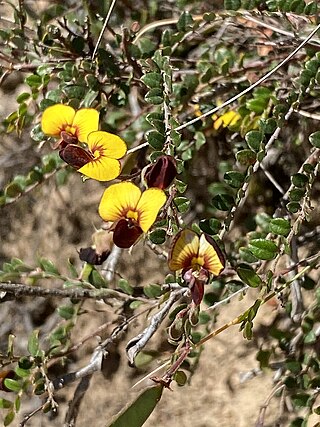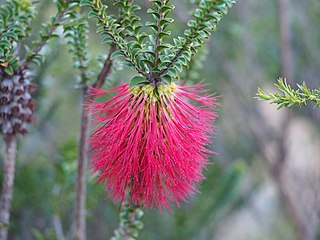
Swainsona galegifolia commonly known as smooth Darling pea, is a species of flowering plant in the family Fabaceae and is endemic to Australia. It is a small shrub with greyish-green leaves and flowers in white, red, pink, purple, yellow or orange.

Dillwynia retorta, commonly known as eggs and bacon, is a species of flowering plant shrub in the family Fabaceae and grows in New South Wales and Queensland. It is usually an erect shrub with thin, smooth, crowded leaves and yellow flowers with red markings.

Beaufortia sparsa, commonly known as swamp bottlebrush, is a plant in the myrtle family Myrtaceae, and is endemic to the southwest of Western Australia. It is an erect or spreading shrub with round, dished leaves crowded on the younger stems, and bright red flower spikes in the warmer months.

Pultenaea scabra, commonly known as rough bush-pea, is a species of flowering plant in the family Fabaceae and is endemic to south-eastern continental Australia. It is an erect or spreading shrub with hairy stems, heart-shaped leaves with the narrower end towards the base, and yellow and red, pea-like flowers.

Kennedia prostrata, commonly known as running postman, scarlet coral pea or scarlet runner, is a species of flowering plant in the family Fabaceae and is endemic to Australia. It is a prostrate or twining shrub with trifoliate leaves and, usually, red flowers.

Melaleuca fulgens, commonly known as the scarlet honey myrtle, is a plant in the myrtle family Myrtaceae, and is endemic to Western Australia, South Australia and the Northern Territory. It is notable for its showy orange, red or purple flowers, unusual foliage and fruit, and is a popular garden plant. It is a member of Melaleuca, a large and diverse genus whose members range from large trees such as M. quinquenervia, to small shrubs.

Melaleuca pulchella, commonly known as claw flower and claw honey-myrtle, is a plant in the myrtle family Myrtaceae, and is endemic to the south of Western Australia. It is one of only two species of Melaleuca to have two kinds of stamens. The outer stamens are longer and curved, giving the appearance of a claw to the flower. It is a hardy shrub flowering over a long period, and has been a popular garden plant for many years.

Oxylobium ellipticum, commonly known as the common shaggy-pea, is a flowering plant in the family Fabaceae. It has dense clusters of yellow pea flowers and elliptic-shaped leaves. It grows in south-eastern Australia.

Melaleuca decussata, commonly known as cross-leaf honey-myrtle or totem poles, is a plant in the myrtle family, Myrtaceae native to South Australia and both native and naturalised in Victoria. It is an adaptable shrub, grown in many parts of Australia for its attractive foliage but is regarded as an environmental weed in parts of Victoria.

Oxylobium arborescens, commonly known as the tall shaggy-pea, is a species of flowering shrub to small tree in the family Fabaceae and is endemic to south-eastern Australia. It has elliptic dark green leaves and yellow pea flowers.

Bossiaea prostrata, commonly known as creeping bossiaea, is a prostrate understory shrub in the pea family, Fabaceae. It is a widespread species with orange-yellow flowers, purple-brown keels and trailing branches.

Bossiaea cinerea, commonly known as showy bossiaea, is a species of flowering plant in the family Fabaceae and is endemic to south-eastern Australia. It is an erect or spreading shrub with trowel-shaped, triangular, egg-shaped or lance-shaped leaves with a sharply-pointed tip and golden yellow and red to purplish-brown flowers.

Melaleuca calycina is a shrub in the myrtle family, Myrtaceae, and is endemic to the south-west of Western Australia. It is a stiff, erect shrub with oval to heart-shaped leaves, white flowers and star-shaped fruit.

Melaleuca densa is a shrub in the myrtle family, Myrtaceae and is endemic to the south-west of Western Australia. It is a bushy shrub with profuse cream, yellow or greenish flowers and overlapping leaves on the youngest shoots.

Beaufortia decussata, commonly known as gravel bottlebrush, is a species of flowering plant in the myrtle family, Myrtaceae and is endemic to the southwest of Western Australia. It has long stems branching only near the upper ends, and scarlet to orange-red flowers in a bottlebrush shape beneath the branches.

Bossiaea linophylla is a species of flowering plant in the family Fabaceae and is endemic to the south-west of Western Australia. It is a spreading shrub with linear to oblong or egg-shaped leaves, and bright yellow to orange or apricot-coloured and red flowers.

Hovea longifolia commonly known as rusty pods, is a flowering plant in the family Fabaceae, endemic to eastern Australia. It has purple pea flowers, linear leaves with rusty felt like hairs on the lower surface.

Bossiaea dentata is a species of flowering plant in the family Fabaceae and is endemic to the south of Western Australia. It is an erect, sometimes prostrate shrub with variably-shaped leaves and greenish-yellow or pink to burgundy-coloured flowers.

Bossiaea rufa is a species of flowering plant in the family Fabaceae and is endemic to the south-west of Western Australia. It is a loose, many-branched shrub with elliptic to egg-shaped leaves with the narrower end towards the base, and deep yellow and red flowers.

Gompholobium venustum, commonly known as handsome wedge-pea, is a species of flowering plant in the family Fabaceae and is endemic to the south-west of Western Australia. It is a slender, erect or sprawling shrub with pinnate leaves with fifteen to nineteen leaflets, and yellow or pink, pea-like flowers.




















